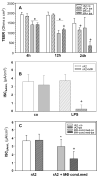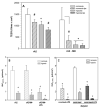Hypoxia Aggravates Inhibition of Alveolar Epithelial Na-Transport by Lipopolysaccharide-Stimulation of Alveolar Macrophages
- PMID: 35955448
- PMCID: PMC9368968
- DOI: 10.3390/ijms23158315
Hypoxia Aggravates Inhibition of Alveolar Epithelial Na-Transport by Lipopolysaccharide-Stimulation of Alveolar Macrophages
Abstract
Inflammation and hypoxia impair alveolar barrier tightness, inhibit Na- and fluid reabsorption, and cause edema. We tested whether stimulated alveolar macrophages affect alveolar Na-transport and whether hypoxia aggravates the effects of inflammation, and tested for involved signaling pathways. Primary rat alveolar type II cells (rA2) were co-cultured with rat alveolar macrophages (NR8383) or treated with NR8383-conditioned media after stimulation with lipopolysaccharide (LPS; 1 µg/mL) and exposed to normoxia and hypoxia (1.5% O2). LPS caused a fast, transient increase in TNFα and IL-6 mRNA in macrophages and a sustained increase in inducible nitric oxide synthase (NOS2) mRNA in macrophages and in rA2 cells resulting in elevated nitrite levels and secretion of TNF-α and IL-6 into culture media. In normoxia, 24 h of LPS treated NR8383 decreased the transepithelial electrical resistance (TEER) of co-cultures, of amiloride-sensitive short circuit current (ISCΔamil); whereas Na/K-ATPase activity was not affected. Inhibition was also seen with conditioned media from LPS-stimulated NR8383 on rA2, but was less pronounced after dialysis to remove small molecules and nitrite. The effect of LPS-stimulated macrophages on TEER and Na-transport was fully prevented by the iNOS-inhibitor L-NMMA applied to co-cultures and to rA2 mono-cultures. Hypoxia in combination with LPS-stimulated NR8383 totally abolished TEER and ISCΔamil. These results indicate that the LPS-stimulation of alveolar macrophages impairs alveolar epithelial Na-transport by NO-dependent mechanisms, where part of the NO is produced by rA2 induced by signals from LPS stimulated alveolar macrophages.
Keywords: Na/K-ATPase; alveolar epithelial Na-channels; alveolar macrophages; hypoxia; iNOS; inflammation; pulmonary edema.
Conflict of interest statement
The authors declare no conflict of interest.
Figures






Similar articles
-
[The effect of lipopolysaccharide on gene expression of TLR4 and MD-2 in rat alveolar macrophage and its secretion of inflammation cytokines].Zhonghua Jie He He Hu Xi Za Zhi. 2010 May;33(5):367-71. Zhonghua Jie He He Hu Xi Za Zhi. 2010. PMID: 20646617 Chinese.
-
Dexamethasone prevents transport inhibition by hypoxia in rat lung and alveolar epithelial cells by stimulating activity and expression of Na+-K+-ATPase and epithelial Na+ channels.Am J Physiol Lung Cell Mol Physiol. 2007 Nov;293(5):L1332-8. doi: 10.1152/ajplung.00338.2006. Epub 2007 Sep 14. Am J Physiol Lung Cell Mol Physiol. 2007. PMID: 17873005
-
[Effect of lncRNA-AC013472.3 on LPS-stimulated secretion of tumor necrosis factor-α in NR8383 rat alveolar macrophages].Zhonghua Yi Xue Za Zhi. 2020 Mar 31;100(12):899-903. doi: 10.3760/cma.j.cn112137-20191129-02602. Zhonghua Yi Xue Za Zhi. 2020. PMID: 32234163 Chinese.
-
Inhibition of nitric oxide synthase abrogates lipopolysaccharides-induced up-regulation of L-arginine uptake in rat alveolar macrophages.Br J Pharmacol. 2001 Jun;133(3):379-86. doi: 10.1038/sj.bjp.0704091. Br J Pharmacol. 2001. PMID: 11375254 Free PMC article.
-
Alveolar macrophages initiate the systemic microvascular inflammatory response to alveolar hypoxia.Respir Physiol Neurobiol. 2011 Sep 30;178(3):439-48. doi: 10.1016/j.resp.2011.03.008. Epub 2011 Mar 21. Respir Physiol Neurobiol. 2011. PMID: 21402178 Free PMC article. Review.
Cited by
-
Submersion and hypoxia inhibit alveolar epithelial Na+ transport through ERK/NF-κB signaling pathway.Respir Res. 2023 Apr 24;24(1):117. doi: 10.1186/s12931-023-02428-z. Respir Res. 2023. PMID: 37095538 Free PMC article.
-
Atelectasis predicts poor prognosis in pediatric macrolides-unresponsive Mycoplasma pneumoniae pneumonia with A2063/2064G mutations treated with azithromycin.Front Cell Infect Microbiol. 2025 Jun 27;15:1604102. doi: 10.3389/fcimb.2025.1604102. eCollection 2025. Front Cell Infect Microbiol. 2025. PMID: 40654577 Free PMC article.
-
Hypoxic Stress-Dependent Regulation of Na,K-ATPase in Ischemic Heart Disease.Int J Mol Sci. 2023 Apr 26;24(9):7855. doi: 10.3390/ijms24097855. Int J Mol Sci. 2023. PMID: 37175562 Free PMC article. Review.
-
Low-pressure exposure influences the development of HAPE.Open Life Sci. 2025 Apr 1;20(1):20221029. doi: 10.1515/biol-2022-1029. eCollection 2025. Open Life Sci. 2025. PMID: 40177420 Free PMC article.
-
Inhalation of panaxadiol alleviates lung inflammation via inhibiting TNFA/TNFAR and IL7/IL7R signaling between macrophages and epithelial cells.J Ginseng Res. 2024 Jan;48(1):77-88. doi: 10.1016/j.jgr.2023.09.002. Epub 2023 Sep 23. J Ginseng Res. 2024. PMID: 38223829 Free PMC article.
References
MeSH terms
Substances
Grants and funding
LinkOut - more resources
Full Text Sources

